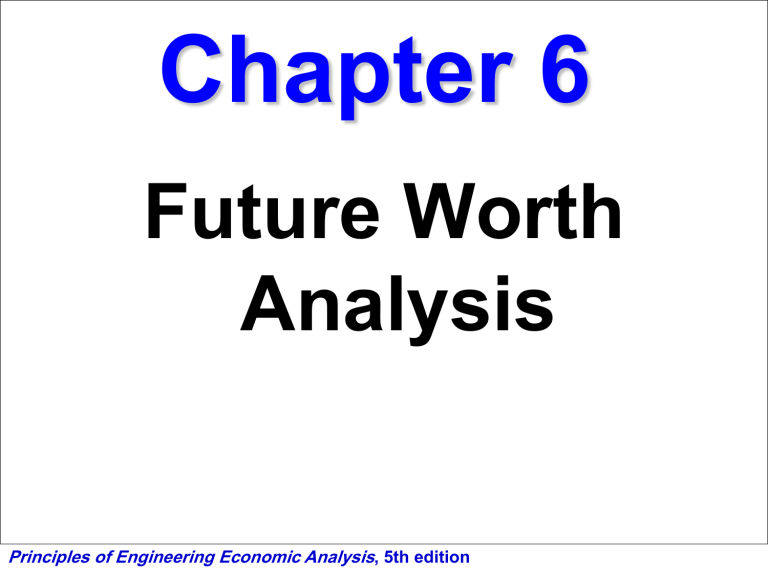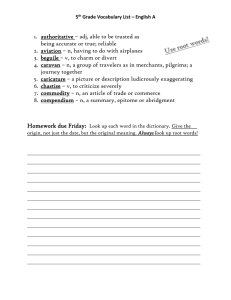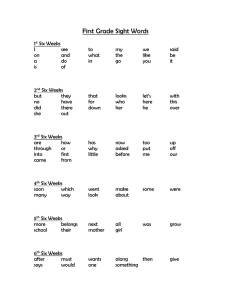
Chapter 6
Future Worth
Analysis
Principles of Engineering Economic Analysis, 5th edition
Systematic Economic Analysis Technique
1. Identify the investment alternatives
2. Define the planning horizon
3. Specify the discount rate
4. Estimate the cash flows
5. Compare the alternatives
6. Perform supplementary analyses
7. Select the preferred investment
Principles of Engineering Economic Analysis, 5th edition
Future Worth Analysis
Single Alternative
Principles of Engineering Economic Analysis, 5th edition
Future Worth Method
converts all cash flows to a single sum
equivalent at the end of the planning
horizon using i = MARR
used mostly for financial planning
not a popular corporate DCF method
n
FW ( i %)
A t (1 i )
nt
t0
(take all cash flows to “time n” and add
them up!)
Principles of Engineering Economic Analysis, 5th edition
Example 6.1
A $500,000 investment in a surface mount
placement machine is being considered. Over a
10-year planning horizon, it is estimated the SMP
machine will produce net annual savings of
$92,500. At the end of 10 years, it is estimated the
SMP machine will have a $50,000 salvage value.
Based on a 10% MARR and future worth analysis,
should the investment be made?
FW = -$500K(F|P 10%,10) + $92.5K(F|A 10%,10) + $50K
= $227,341.40
=FV(10%,10,-92500,500000)+50000
= $227,340.55
Principles of Engineering Economic Analysis, 5th edition
Example 6.2
How does future worth change over the life of the
investment? How does future worth change when
the salvage value decreases geometrically and as
a gradient series?
Principles of Engineering Economic Analysis, 5th edition
Principles of Engineering Economic Analysis, 5th edition
Future Worth of the SMP Machine Investment
geometric
gradient
$250,000
$200,000
$150,000
$100,000
$50,000
$0
-$50,000
1
2
3
4
5
6
7
8
-$100,000
-$150,000
Length of the Planning Horizon (Yrs)
Principles of Engineering Economic Analysis, 5th edition
9
10
Notice, a negative FW occurs until
the 3rd year with gradient decreases
and until the 7th year with geometric
decreases; also, FW achieves a
minimum during the 1st year with
gradient decreases and during the 3rd
year with geometric decreases.
Principles of Engineering Economic Analysis, 5th edition
Example 6.3
A recent engineering graduate began investing at age 23,
with a goal of achieving a net worth of $5 million by age 58.
If the engineer obtains an annual return of 6.5% and makes
a first investment of $5000, what gradient increase is
required?
G(A|G 6.5%,36) + $5000 = $5,000,000(A|F 6.5%,36)
G = [$5,000,000(A|F 6.5%,36) - $5000]/(A|G 6.5%,36)
(A|F 6.5%,36) = 0.065/[(1.065)36 – 1] = 0.0075133
(A|G 6.5%,36) = {(1.065)36 – [1 + 36(0.065)]}/{0.065[(1.065)36 – 1]}
= 11.22339
G = [$5,000,000(0.0075133) - $5000]/11.22339 = $2901.66
Principles of Engineering Economic Analysis, 5th edition
Example 6.3 (Continued)
Suppose the return on the investment is quite uncertain.
Specifically, suppose it can be between 4% and 10%. What
will be the impact on the value of the investment portfolio
when the engineer is 58?
Answer: it will have a value between $3.41 million and
$9.13 million.
Principles of Engineering Economic Analysis, 5th edition
Principles of Engineering Economic Analysis, 5th edition
Example 6.3 (Continued)
Suppose the engineer makes geometric increases in
annual investments. Specifically, suppose annual
investments increase by 3%, 4%, 5%, 6%, 7%, or 8%. What
will be the impact on the value of the investment portfolio
when the engineer is 58?
Answer: it will have a value between $0.6 million and $3.7
million.
Principles of Engineering Economic Analysis, 5th edition
Principles of Engineering Economic Analysis, 5th edition
Example 6.3 (Continued)
Based on the results of the analysis, the engineer decides
to increase by $2500 the annual investment until age 40;
the next 18 annual investments are 5% greater than the
previous investment. What will be the impact on the value
of the investment portfolio when the engineer is 58?
Answer: The investment portfolio will equal $5,819,498.50.
Principles of Engineering Economic Analysis, 5th edition
Principles of Engineering Economic Analysis, 5th edition
Example 6.3 (Continued)
Based on the previous results with a combination of
gradient and geometric increases in annual investments,
what will be the effect on the investment portfolio at age 58
if the geometric increases are 3%, 4%, 5%, 6%, 7%, and 8%,
and the annual return on investment in the portfolio ranges
from 4% to 10% in half percent increments?
Answer: The investment portfolio will range from $2.8
million to $9.1 million.
Principles of Engineering Economic Analysis, 5th edition
Principles of Engineering Economic Analysis, 5th edition
S ize o f t he Inv e s t m e nt P o rt f o lio f o r V a rio us G e o m e t ric R a t e s o f Inc re a s e in A nnua l
Inv e s t m e nt s a f t e r A ge 4 0
3%
4%
5%
6%
7%
8%
$ 10 , 0 0 0 , 0 0 0
$9,000,000
Fuure Worth
$8,000,000
$7,000,000
$6,000,000
$5,000,000
$4,000,000
$3,000,000
$2,000,000
4.0%
4.5%
5.0%
5.5%
6.0%
6.5%
7.0%
7.5%
8.0%
Annual Return on Investm ent
Principles of Engineering Economic Analysis, 5th edition
8.5%
9.0%
9.5%
10 . 0 %
Future Worth Analysis
Multiple Alternatives
Principles of Engineering Economic Analysis, 5th edition
Example 6.4
Recall the example involving two design alternatives (A & B) for a new
ride (The Scream Machine) in a theme park. A costs $300,000, has
revenue of $55,000/yr, and has a negligible salvage value at the end of
the 10-year planning horizon; B costs $450,000, has revenue of
$80,000/yr, and has a negligible salvage value. Based on a FW analysis
and a 10% MARR, which is preferred?
FWA(10%)
FWB(10%)
= -$300,000(F|P 10%,10) + $55,000(F|A 10%,10)
= $98,436.10
=FV(10%,10,-55000,300000) = $98,435.62
= -$450,000(F|P 10%,10) + $80,000(F|A 10%,10)
= $107,810.60
=FV(10%,10,-80000,450000) = $107,809.86
Analyze the impact on FW based on salvage values decreasing
geometrically to 1¢ after 10 years; analyze the impact of changes in the
MARR on the recommendation; and perform incremental analysis.
Principles of Engineering Economic Analysis, 5th edition
Example 6.4
Recall the example involving two design alternatives (A & B) for a new
ride (The Scream Machine) in a theme park. A costs $300,000, has
revenue of $55,000/yr, and has a negligible salvage value at the end of
the 10-year planning horizon; B costs $450,000, has revenue of
$80,000/yr, and has a negligible salvage value. Based on a FW analysis
and a 10% MARR, which is preferred?
FWA(10%)
FWB(10%)
= -$300,000(F|P 10%,10) + $55,000(F|A 10%,10)
= $98,436.10
=FV(10%,10,-55000,300000) = $98,435.62
= -$450,000(F|P 10%,10) + $80,000(F|A 10%,10)
= $107,810.60
=FV(10%,10,-80000,450000) = $107,809.86
Analyze the impact on FW based on salvage values decreasing
geometrically to 1¢ after 10 years; and analyze the impact of changes
in the MARR on the recommendation.
Principles of Engineering Economic Analysis, 5th edition
Example 6.5
A recent 22-year old engineering graduate is choosing
between 2 retirement plans: with plan 1, up to 4% of salary
is matched by employer and, in the past, has earned 6%
annual returns; with plan 2, a 1.5% fee is paid, matching up
to 4% still occurs, and the investments being considered
return between 2% and 12% annually. Her current salary is
$55,000; she assumes her salary will increase at an annual
rate of 5%. Which should she choose?
FW1(6%) = 2(0.04)($55,000)(F|A1 6%,5%,40) = $1,428,120.90
FW2(2%) = 2(0.04)($55,000)(0.985)(F|A1 2%,5%,40) = $698,055.57
FW2(12%) = 2(0.04)($55,000)(0.985)(F|A1 12%,5%,40) = $5,325,308.50
She chose the 2nd plan; which would you choose?
Principles of Engineering Economic Analysis, 5th edition
Example 6.6
Recall the example with two design alternatives for The Scream
Machine: A costs $300,000, has revenue of $55,000/yr, and has a
negligible salvage value at the end of the 10-year planning horizon; and
B costs $450,000, has revenue of $80,000/yr, and has a negligible
salvage value. Based on an incremental FW analysis and a 10% MARR,
which is preferred?
= -$300,000(F|P 10%,10) + $55,000(F|A 10%,10)
= $98,436.10 > $0
=FV(10%,10,-55000,300000) = $98,435.62 > $0
(A is better than “do nothing”)
FWB-A(10%) = -$150,000(F|P 10%,10) + $25,000(F|A 10%,10)
= $9374.50 > $0
=FV(10%,10,-25000,150000)
= $9374.25 > $0
(B is better than A)
Prefer B
FWA(10%)
Principles of Engineering Economic Analysis, 5th edition
Principles of Engineering Economic Analysis, 5th edition
Incremental Future Worth as a Function of the MARR
$100,000
$50,000
-$100,000
-$150,000
-$200,000
-$250,000
-$300,000
MARR
Principles of Engineering Economic Analysis, 5th edition
20%
18%
16%
14%
12%
10%
8%
6%
4%
2%
-$50,000
0%
$0
Example 6.8
Perform an investment portfolio analysis for the
investment involving two design alternatives for The
Scream Machine.
FWDN(10%) = $450,000(F|P 10%,10) = $1,167,183.00
=FV(10%,10,,-450000) = $1,167,184.11
FWB(10%) = $80,000(F|A 10%,10) = $1,274,993.60
=FV(10%,10,-80000) = $1,274,993.97
FWA(10%) = $55,000(F|A 10%,10) + $150,000(F|P 10%,10)
= $1,265,619.10
=FV(10%,10,-55000)+FV(10%,10,,-150000)
= $1,265,619.72
Principles of Engineering Economic Analysis, 5th edition
More on Unequal Lives
Principle #8
Compare investment alternatives
over a common period of time
Principles of Engineering Economic Analysis, 5th edition
Example 6.9
If an investor’s MARR is 12%, which mutually exclusive
investment alternative maximizes the investor’s future
worth, given the parameters shown below?
EOY
0
1
2
3
4
5
6
CF(1)
-$10,000
$5,000
$5,000
$10,000
CF(2)
-$15,000
$5,000
$5,000
$5,000
$5,000
$5,000
$7,500
CF(3)
-$20,000
$0
$3,000
$6,000
$9,000
$12,000
$15,000
What planning horizon should be used? What assumptions
are made regarding Alt. 1 for years 4, 5, and 6?
Principles of Engineering Economic Analysis, 5th edition
Example 6.9 (Continued)
If we use a 6-year planning horizon and assume no cash
flows will occur in years 4, 5, and 6 for Alt. 1, the future
worths will be as follows:
FW1(12%) = -$10,000(F|P 12%,6)
+ [$5000(F|A 12%,3) + $5000](F|P 12%,3) = $10,990.43
=FV(12%,6,-5000,10000)+FV(12%,3,5000,-5000) = $10,990.36
FW2(12%) = -$14,500(F|P 12%,6) + $5000(F|A 12%,6) = $11,955.56
=FV(12%,6,-5000,14500) = $11,955.52
FW3(12%) = -$20,000(F|P 12%,6) + $3000(A|G 12%,6)(F|A 12%,6)
= $13,403.40
=FV(12%,6,-1000*NPV(12%,0,3,6,9,12,15)+20000) = $13,403.27
Principles of Engineering Economic Analysis, 5th edition
Example 6.9 (Continued)
If we use a 6-year planning horizon and assume Alt. 1
repeats with identical cash flows for years 4, 5, and 6 for
Alt. 1, the cash flow profiles will be as follows:
EOY
0
1
2
3
4
5
6
CF(1')
-$10,000
$5,000
$5,000
$0
$5,000
$5,000
$10,000
CF(2)
-$15,000
$5,000
$5,000
$5,000
$5,000
$5,000
$7,500
Principles of Engineering Economic Analysis, 5th edition
CF(3)
-$20,000
$0
$3,000
$6,000
$9,000
$12,000
$15,000
Example 6.9 (Continued)
Under the assumption that Alt. 1 is repeated with identical cash flows for
years 4, 5, and 6, the future worths will be as follows:
FW1(12%) = -$10,000(F|P 12%,6) + $5000(F|A 12%,6) - $5000(F|P 12%,3)
+ $5000
=FV(12%,6,-5000,10000)+FV(12%,3,,5000)+5000
= $18,813.08
FW2(12%) = -$14,500(F|P 12%,6) + $5000(F|A 12%,6)
=FV(12%,6,-5000,14500)
= $11,955.52
FW3(12%) = -$20,000(F|P 12%,6) + $3000(A|G 12%,6)(F|A 12%,6)
=FV(12%,6,-1000*NPV(12%,0,3,6,9,12,15)+20000)
= $13,403.27
Is it reasonable to assume an investment alternative equivalent to Alt. 1
will be available in 3 years? If so, why was the MARR set equal to 12%?
Principles of Engineering Economic Analysis, 5th edition
Future Worths Assuming Investment 1 Is Not Repeated
Investment 1
Investment 2
Investment 3
MARR
Principles of Engineering Economic Analysis, 5th edition
18%
17%
16%
15%
14%
13%
12%
11%
10%
$11,800.00
$11,600.00
$11,400.00
$11,200.00
$11,000.00
$10,800.00
$10,600.00
$10,400.00
$10,200.00
$10,000.00
$9,800.00
Pit Stop #6—It’s Time to Put the Peddle to the Metal!
1.
2.
3.
4.
5.
6.
True or False: Future worth analysis is the most popular
DCF measure of economic worth.
True or False: Unless non-monetary considerations
dictate otherwise, choose the mutually exclusive
investment alternative that has the greatest future worth,
regardless of the lives of the alternatives.
True or False: If FW > 0 when the MARR = 20%, then
DPBP < 5 years.
True or False: If FW < 0, then PW < 0.
True or False: If FW(A) > FW(B), then DPBP(A) <
DPBP(B), and PBP(A) < PBP(B).
True or False: When using future worth analysis with
mutually exclusive alternatives having unequal lives, use
a planning horizon equal to the least common multiple of
lives.
Principles of Engineering Economic Analysis, 5th edition
Pit Stop #6—It’s Time to Put the Peddle to the Metal!
1.
2.
3.
4.
5.
6.
True or False: Future worth analysis is the most popular
DCF measure of economic worth. FALSE
True or False: Unless non-monetary considerations
dictate otherwise, choose the mutually exclusive
investment alternative that has the greatest future worth,
regardless of the lives of the alternatives. FALSE
True or False: If FW > 0 when the MARR = 20%, then
DPBP < 5 years. FALSE
True or False: If FW < 0, then PW < 0. TRUE
True or False: If FW(A) > FW(B), then DPBP(A) <
DPBP(B), and PBP(A) < PBP(B). FALSE
True or False: When using future worth analysis with
mutually exclusive alternatives having unequal lives, use
a planning horizon equal to the least common multiple of
lives. FALSE (it is situation and circumstance dependent)
Principles of Engineering Economic Analysis, 5th edition




